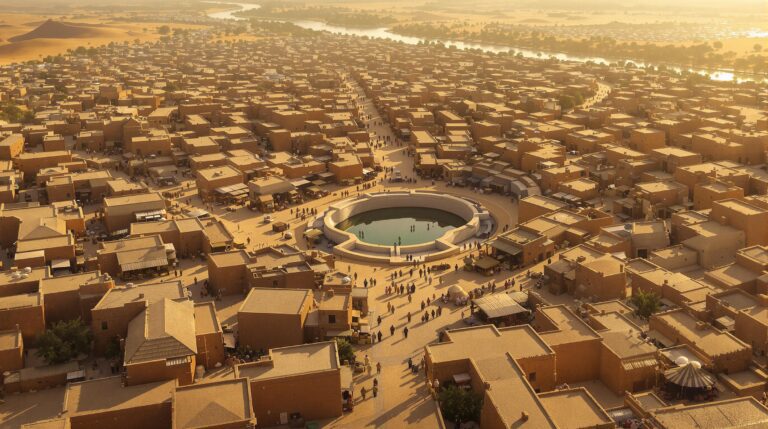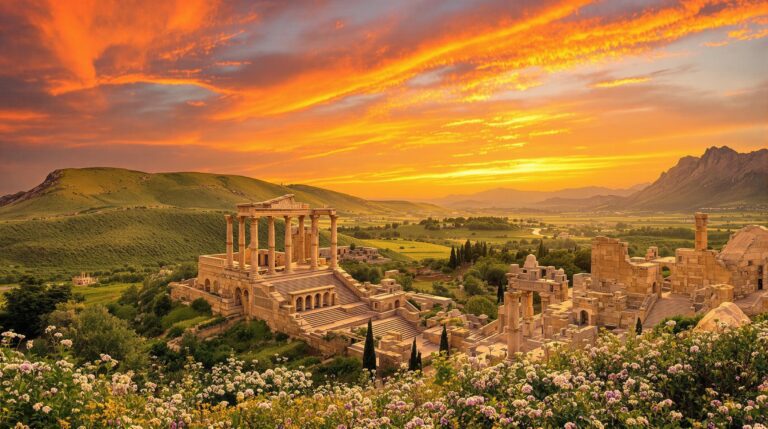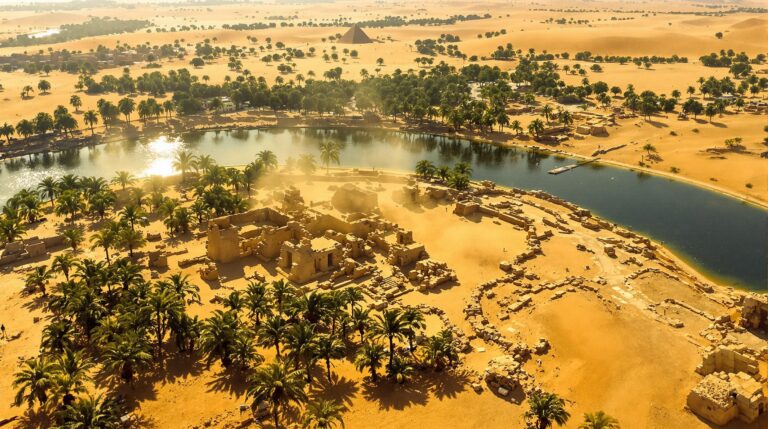Babylon: Ancient City of Power and Mystery
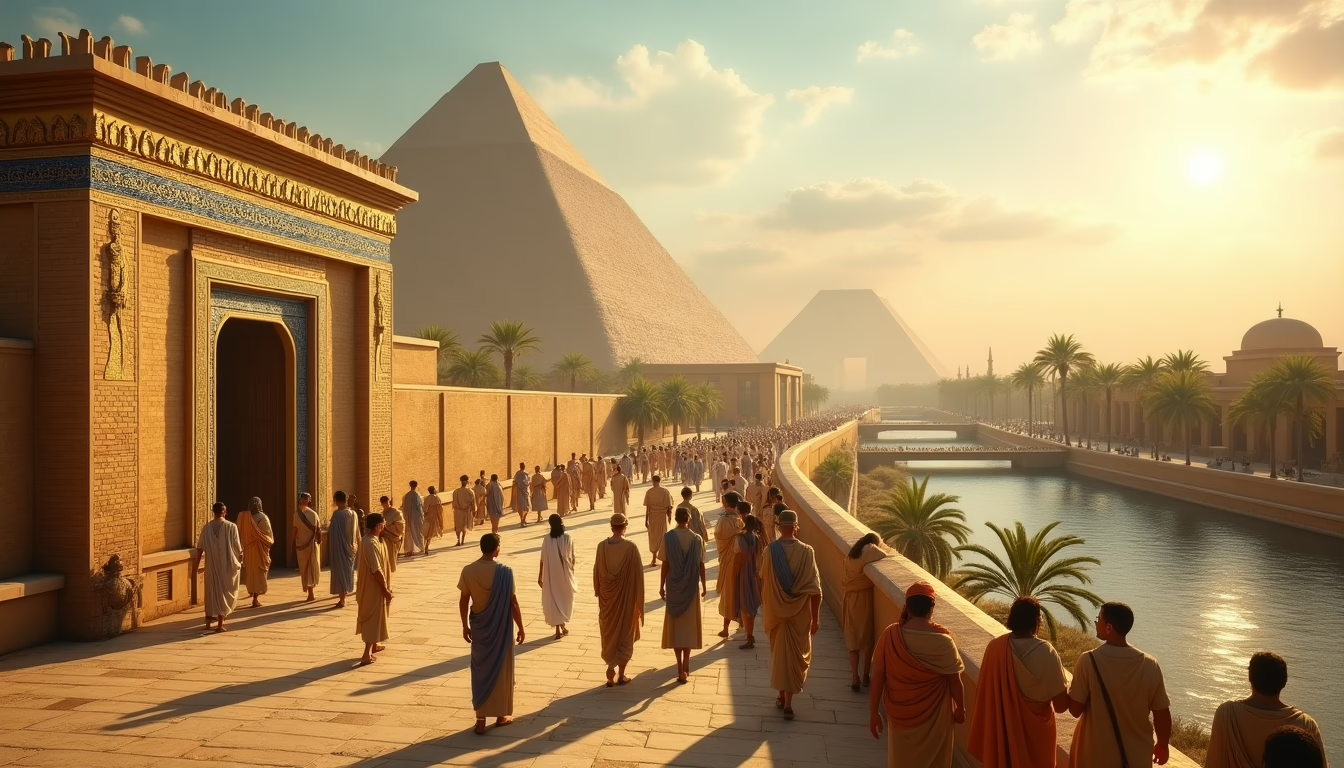
Babylon stands as a tribute to ancient civilization’s complexity and ambition.
Its strategic location fostered trade and cultural exchange, while its architectural marvels showcased innovative urban planning.
The city’s varied fabric of religion and knowledge shaped societal norms and legal frameworks that resonate through history.
Yet, questions linger about the forces that propelled Babylon to greatness and the reasons for its eventual decline. What secrets lie within its storied past?
Summary & Key Takeaways
Hide- Babylon evolved from a small settlement to a dominant regional power under the Amorite Dynasty, particularly during Hammurabi's reign.
- The city was strategically located along the Euphrates River, facilitating trade, agriculture, and military mobility.
- Architectural wonders like the Ziggurat of Etemenanki and the Ishtar Gate showcased Babylon's cultural significance and engineering prowess.
- Babylon's religious life centered around a pantheon of gods, with Marduk as the principal deity influencing society and politics.
- The Neo-Babylonian Empire, under Nebuchadnezzar II, marked a period of cultural flourishing and territorial expansion, leaving a lasting legacy.
Origins of Babylon and Its Rise Along the Euphrates
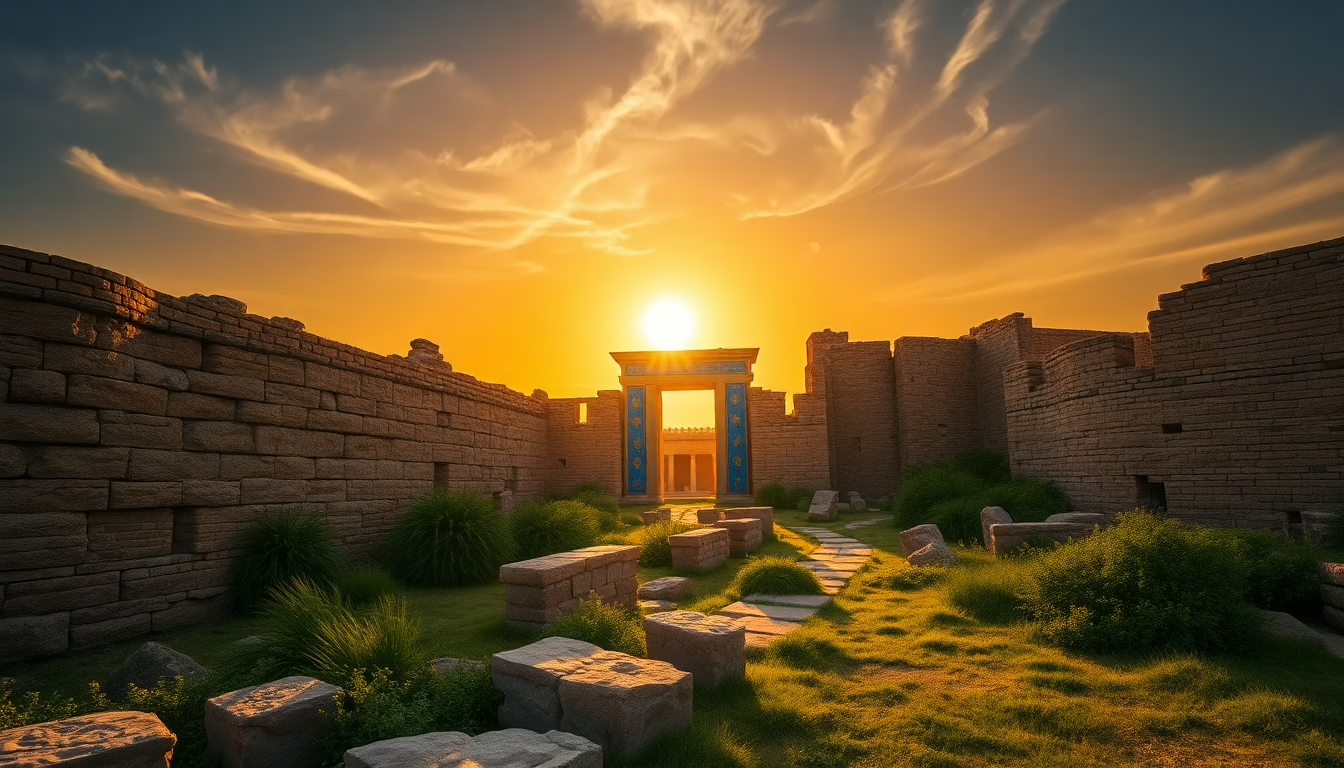
The origins of Babylon reflect a remarkable transformation from a modest settlement to a formidable regional power along the Euphrates River.
Central to this evolution was the Amorite Dynasty, particularly under the leadership of Hammurabi, whose legal innovations and military conquests solidified Babylon’s influence.
This period marked not only the rise of a city but the emergence of a complex societal framework that would leave an indelible mark on future civilizations.
From a Small Town to a Regional Power
The geographic positioning of Babylon along the Euphrates River afforded it significant access to essential trade routes, facilitating economic growth and cultural exchange.
Influenced by the sophisticated societies of the ancient Sumerians and Akkadians, Babylon gradually transformed from a modest settlement into a formidable regional power.
This evolution underscores the interplay between geography and cultural dynamics in shaping the trajectory of ancient civilizations.
Geographic Significance and Access to Trade Routes
Located along the banks of the Euphrates River, Babylon’s geographic positioning played a crucial role in its transformation from a modest settlement into a formidable regional power.
Its strategic access facilitated:
- Trade with neighboring civilizations
- Agricultural abundance from river irrigation
- Cultural exchanges and innovations
- Military advantages through mobility
- Economic prosperity, fostering urban development
These factors collectively propelled Babylon into prominence, shaping its historical trajectory.
Influence of the Sumerians and Akkadians
Although Babylon began as a modest town, its ascent to power can be traced back to the profound influence of the Sumerians and Akkadians, who laid the foundational elements of civilization in Mesopotamia.
Their innovations in writing, law, and urban planning provided Babylon with the essential tools for governance and commerce, enabling it to flourish and eventually dominate the region.
The Amorite Dynasty and Hammurabi’s Rule
The Amorite Dynasty, particularly under Hammurabi’s leadership, marked a pivotal era in Babylon’s ascent as a dominant power in Mesopotamia.
His unification of the region not only established Babylon as a central authority but also led to the creation of the Code of Hammurabi, a groundbreaking legal framework that would influence governance for centuries.
This intersection of political savvy and legal innovation set the stage for a legacy that transcended its time, reshaping societal norms and justice in the ancient world.
Unification of Mesopotamia Under Hammurabi
Amidst the shifting sands of time, Babylon emerged as a formidable power in ancient Mesopotamia, particularly during the reign of Hammurabi, who unified the region under his rule.
This unification was marked by:
- Strategic alliances
- Military conquests
- Economic integration
- Cultural exchanges
- Administrative reforms
These elements coalesced to establish a cohesive society, laying the groundwork for future governance and civilization in the region.
Creation of the Code of Hammurabi and Its Lasting Impact
Following the unification of Mesopotamia under Hammurabi, the establishment of the Code of Hammurabi marked a significant milestone in the development of legal systems.
This codification of laws, emphasizing justice and social order, laid foundational principles that resonate through time. Its influence extended beyond Babylon, shaping future legal frameworks and notions of rights, ultimately advocating for a society where freedom and accountability coexist.
Architectural Wonders and Urban Planning
The architectural achievements of Babylon reflect a sophisticated understanding of urban planning and religious significance.
Structures like the Ziggurat of Etemenanki exemplify the city’s spiritual ambitions, while the legendary Hanging Gardens challenge perceptions of ancient engineering.
Additionally, the grandeur of the Ishtar Gate and its Processional Way illustrates the intricate relationship between architecture and cultural identity in this remarkable civilization.
The Ziggurat of Etemenanki and Its Role in Babylonian Religion
The Ziggurat of Etemenanki stands as a monumental symbol of the Babylonian worldview, embodying the profound connection between the divine and the earthly domain.
Its architectural grandeur not only served religious purposes but also likely inspired the biblical narrative of the Tower of Babel, reflecting humanity’s aspiration to bridge the gap between heaven and earth.
This interplay of faith and urban design reveals the ziggurat’s pivotal role in shaping both the spiritual and social landscape of ancient Babylon.
Symbolic Connection Between Heaven and Earth
In the heart of Babylon, the Ziggurat of Etemenanki stood as a monumental embodiment of the ancient civilization’s profound relationship with the divine.
This architectural marvel symbolized the connection between heaven and earth through:
- Vertical ascent to the gods
- Ritualistic significance
- Urban planning alignment
- Community unity
- Cosmic order representation
Such elements showcased Babylon’s quest for transcendence and spiritual harmony, inviting reflection on humanity’s eternal search for meaning.
Possible Inspiration for the Tower of Babel
While many ancient structures served as religious and civic centers, the Ziggurat of Etemenanki uniquely blended architectural innovation with profound cultural significance, potentially inspiring the legendary Tower of Babel.
Its monumental scale and tiered design echoed humanity’s desire to reach the divine, symbolizing ambition and unity.
This nexus of faith and urbanity reflects the complexities of human aspiration, imbuing the tower’s narrative with deep meaning.
The Hanging Gardens: Fact, Fiction, or Misplaced Wonder?
The Hanging Gardens of Babylon have long captivated historians and architects alike, sparking debates about their existence and design.
Ancient accounts describe a magnificent terraced garden, yet the precise location and engineering techniques remain elusive, leading to speculation about their authenticity.
This intriguing blend of myth and reality invites a closer examination of urban planning in ancient civilizations and the enduring allure of architectural marvels.
Ancient Descriptions of a Lush Terraced Garden
Although the existence of the Hanging Gardens of Babylon is shrouded in myth, ancient descriptions portray them as a breathtaking achievement of architectural ingenuity and urban planning.
These accounts hint at:
- A series of ascending terraces
- An intricate irrigation system
- Diverse flora and fauna
- A visual spectacle of lush greenery
- A symbol of human creativity over nature
Such elements evoke wonder and contemplation of civilization’s aspirations.
Theories on Its Location and Engineering Methods
Where might the fabled Hanging Gardens of Babylon have stood, and what engineering marvels could have made their lush terraces a reality?
Various theories suggest locations beyond Babylon, including Nineveh, supported by advanced irrigation systems and innovative plant cultivation techniques.
These speculations challenge the traditional narrative, inviting further exploration of ancient engineering and urban planning, and questioning the boundaries between fact and myth in history.
The Ishtar Gate and Processional Way
The Ishtar Gate, adorned with intricate glazed bricks depicting formidable mythical creatures, stands as a demonstration of Babylon’s architectural ingenuity and artistic mastery.
This grand entrance not only served a decorative purpose but also played an essential role in religious and ceremonial functions, marking the city’s significance as a center of power and worship.
The Processional Way, leading through this monumental gateway, exemplifies the sophisticated urban planning that underpinned Babylon’s grandeur and cultural identity.
Decorative Glazed Bricks Depicting Mythical Creatures
Amidst the grandeur of Babylon’s architectural achievements, the decorative glazed bricks of the Ishtar Gate stand out as an extraordinary manifestation of artistic mastery and cultural symbolism.
These vivid tiles not only embellish the city but also convey deeper meanings, such as:
- Divine protection
- Cultural identity
- Artistic innovation
- Mythical storytelling
- Urban significance
Each brick resonates with the legacy of a civilization that thrived on creativity.
Religious and Ceremonial Functions of the Grand Entrance
Serving as a monumental threshold, the Ishtar Gate not only marked the entrance to Babylon but also embodied the city’s religious and ceremonial significance.
This grand structure facilitated processions, allowing the faithful to engage with the divine. Its intricate designs and symbolic motifs reinforced cultural identity, while echoing the city’s spiritual aspirations, ultimately serving as a conduit between the mundane and the sacred.
Culture, Knowledge, and Daily Life
In Babylon, the intertwining of religion and daily life created a society rich in cultural expression and intellectual achievement.
The pantheon of gods influenced not only spiritual practices but also advancements in mathematics and astronomy, reflecting the civilization’s quest for knowledge.
Art, language, and literacy flourished, serving as both a means of communication and a vehicle for preserving the city’s complex legacy.
Religion and the Pantheon of Gods
In ancient Babylon, Marduk emerged as the principal deity, embodying the city’s aspirations and identity.
The grand temples dedicated to him not only served as places of worship but also as pivotal centers of political and cultural power, shaping the daily lives of its citizens.
This intricate relationship between religion and governance highlights how the pantheon of gods influenced both the spiritual and practical dimensions of Babylonian society.
Marduk as Babylon’s Chief Deity
Marduk, the chief deity of Babylon, epitomized the city’s spiritual and political aspirations, embodying the ideals of justice, wisdom, and strength. His significance extended beyond mere worship, influencing cultural identity and governance.
Key aspects include:
- Symbol of unity and power
- Patron of the arts and sciences
- Enforcer of cosmic order
- Advocate for the oppressed
- Source of hope and renewal
Marduk’s legacy remains profound.
Temples as Centers of Power and Ritual
The temples of Babylon served as essential epicenters of both spiritual and political life, reflecting the city’s profound connection between religion and governance.
Within these sacred spaces, rituals solidified communal identity and reinforced the authority of rulers, intertwining divine favor with political legitimacy.
They were not merely places of worship but strategic hubs, shaping social order and influencing daily life through religious observance and civic duty.
Advancements in Mathematics and Astronomy
Babylon’s advancements in mathematics and astronomy were pivotal in shaping both scholarly pursuits and everyday life.
The early adoption of the sexagesimal number system not only facilitated complex calculations but also influenced timekeeping and geometry.
Additionally, the meticulous observations of celestial patterns exemplified Babylonian ingenuity, laying the groundwork for future astronomical studies and enhancing their understanding of the universe.
Early Use of the Sexagesimal Number System
Although many ancient civilizations contributed to the development of numerical systems, the early use of the sexagesimal system in Mesopotamia marked a significant advancement in mathematics and astronomy.
This base-60 system facilitated:
- Complex calculations
- Timekeeping and calendrical organization
- Architectural precision
- Astronomical observations
- Trade and commerce efficiency
Its enduring influence resonates through modern time measurement, revealing a legacy of intellectual freedom and innovation.
Babylonian Observations of Celestial Patterns
While ancient cultures often looked to the heavens for guidance, the Babylonians distinguished themselves through meticulous observations of celestial patterns that profoundly shaped their society.
Their keen insights into planetary movements and lunar cycles enabled advancements in agriculture, religious rituals, and navigation.
This astronomical expertise not only influenced daily life but also laid foundational principles for future civilizations, illuminating humanity’s quest for understanding the cosmos.
Art, Language, and Literacy
In Babylon, the intertwining of art, language, and literacy served as a foundation for cultural identity and intellectual advancement.
The emergence of cuneiform writing and the establishment of clay tablet libraries facilitated the preservation and dissemination of knowledge, while artistic expressions in carvings and cylinder seals reflected the society’s values and beliefs.
This dynamic interplay not only enriched daily life but also laid the groundwork for future civilizations to build upon.
Cuneiform Writing and Clay Tablet Libraries
Cuneiform writing, one of humanity’s earliest systems of written expression, served as a cornerstone of Babylonian culture and knowledge.
This sophisticated script facilitated communication and preservation of information, empowering individuals and society. Its significance is highlighted through:
- Record-keeping for trade
- Legal documentation
- Literary works
- Scientific observations
- Educational materials
These clay tablet libraries fostered intellectual growth, embodying the pursuit of freedom through knowledge.
Artistic Expressions in Carvings and Cylinder Seals
Artistic expressions in the form of carvings and cylinder seals reveal a lively mosaic of Babylonian culture, encapsulating both the aesthetic values and the social narratives of the time.
These intricate designs served not only as decorative items but also as symbols of identity, power, and mythology, reflecting the complexities of daily life while preserving the rich heritage of this ancient civilization.
The Neo-Babylonian Empire and Nebuchadnezzar II
The Neo-Babylonian Empire, particularly under Nebuchadnezzar II, represents a pivotal era marked by extensive urban development and territorial expansion.
This period not only reshaped the geographical landscape of the ancient Near East but also left an indelible mark on biblical narratives and historical documentation.
Understanding Nebuchadnezzar’s reign is essential for grasping the complexities of power, culture, and influence in one of history’s most significant empires.
Expansion and Urban Development Under Nebuchadnezzar
Under Nebuchadnezzar II, Babylon transformed into a prominent cultural capital, marked by monumental architecture and a flourishing artistic scene.
His military campaigns across the Levant not only expanded the empire’s territory but also facilitated the exchange of ideas and goods, further enriching Babylonian society.
This dual focus on urban development and military conquest solidified Nebuchadnezzar’s legacy and reshaped the region’s geopolitical landscape.
Rebuilding Babylon into a Cultural Capital
Throughout history, few cities have undergone such transformative growth as Babylon during the reign of Nebuchadnezzar II. His ambitious vision fostered a cultural renaissance that reshaped the city’s identity.
Key elements included:
- Restoration of temples
- Construction of the Hanging Gardens
- Development of advanced infrastructure
- Promotion of arts and sciences
- Cultural exchange with neighboring civilizations
These initiatives solidified Babylon’s status as a lively cultural capital.
Military Campaigns Across the Levant
Nebuchadnezzar II’s cultural revitalization of Babylon was paralleled by his military ambitions, which extended the reach of the Neo-Babylonian Empire across the Levant.
His campaigns not only consolidated territories but also facilitated the exchange of ideas and goods, fostering a sense of unity among diverse peoples.
This expansion reinforced Babylon’s power, illustrating the intricate relationship between military might and cultural development in ancient civilizations.
Role in Biblical and Historical Accounts
The Neo-Babylonian Empire, particularly under the reign of Nebuchadnezzar II, played a pivotal role in shaping both historical and biblical narratives, most significantly through the conquest of Jerusalem.
This event marked the beginning of the Babylonian Captivity, a profound experience that would resonate throughout Judeo-Christian traditions.
The legacy of Babylon, steeped in themes of exile and redemption, continues to influence religious thought and historical interpretation to this day.
Conquest of Jerusalem and the Babylonian Captivity
Power and ambition defined the era of the Neo-Babylonian Empire, particularly during the tumultuous period of the conquest of Jerusalem.
Nebuchadnezzar II’s actions triggered significant consequences:
- Destruction of the First Temple
- Forced exile of the Jewish elite
- Cultural assimilation pressures
- Shifts in power dynamics
- Long-lasting psychological impact on the Jewish identity
These events shaped a complex legacy of resilience and adaptation.
Legacy in Judeo-Christian Narratives
How did the legacy of the Neo-Babylonian Empire and its iconic ruler, Nebuchadnezzar II, permeate Judeo-Christian narratives?
His portrayal as a symbol of hubris and divine judgment resonates throughout biblical texts, particularly in the Book of Daniel.
This complex legacy serves as a cautionary tale, inviting reflection on power, exile, and redemption, ultimately shaping theological discussions and moral lessons within Judeo-Christian thought.
Decline and Legacy of Babylon
The decline of Babylon marked a pivotal shift in the ancient world, culminating in its conquest by the Persians, which forever altered the region’s political landscape.
However, the city’s enduring legacy has been resurrected through modern archaeology, shedding light on its monumental achievements and cultural significance.
This intersection of fall and rediscovery invites a deeper examination of how historical narratives shape our understanding of civilization.
Persian Conquest and the Fall of Babylon
The Persian conquest of Babylon marked a pivotal change in the city’s history, characterized by Cyrus the Great’s remarkable entry without a single battle.
This peaceful takeover not only signaled the decline of Babylonian independence but also initiated an administrative shift that integrated Babylon into the vast Persian Empire.
The legacy of this transformation raises intriguing questions about the cultural and political ramifications for both Babylon and its new rulers.
Cyrus the Great’s Entry Without a Battle
Although the fall of Babylon is often associated with military might, the entry of Cyrus the Great into the city exemplified a strategic brilliance that transcended conventional warfare.
His peaceful takeover highlighted:
- Diplomatic acumen over brute force
- The element of surprise
- Understanding of local governance
- Use of propaganda
- Promotion of freedom for the Babylonian people
Cyrus reshaped the narrative of conquest.
Administrative Shift Under Persian Rule
Cyrus the Great’s peaceful entry into Babylon marked not only a change in leadership but also a significant administrative transformation that would reshape the city’s governance under Persian rule.
The Persians implemented a centralized bureaucracy, promoting local autonomy while imposing a system of tribute. This delicate balance fostered stability but diminished Babylon’s once-dominant cultural identity, leaving a legacy of both ingenuity and subjugation.
Rediscovery Through Modern Archaeology
The rediscovery of Babylon through modern archaeology has markedly reshaped the understanding of its historical significance and cultural legacy.
Pioneering excavations led by Robert Koldewey uncovered monumental structures and artifacts, igniting interest in the city’s grandeur.
Meanwhile, ongoing conservation efforts and research continue to illuminate the complexities of Babylon’s decline and its enduring impact on subsequent civilizations.
Excavations at Babylon by Robert Koldewey
Unearthing the remnants of Babylon, Robert Koldewey initiated a groundbreaking journey that would redefine historical understanding of this ancient city.
His excavations revealed:
- The grandeur of the Ishtar Gate
- The intricate ziggurat structures
- Evidence of sophisticated urban planning
- The complexity of Babylonian culture
- Insights into the city’s decline and legacy
Koldewey’s work illuminated the profound impact of Babylon on subsequent civilizations.
Conservation Efforts and Ongoing Research
While the ancient city of Babylon continues to captivate scholars and enthusiasts alike, modern conservation efforts have become essential in preserving its remnants for future generations.
Archaeologists and preservationists collaborate to mitigate damage from environmental factors and urban encroachment, while advanced technologies enhance research methodologies.
These initiatives not only safeguard Babylon’s physical legacy but also stimulate a deeper understanding of its historical significance and cultural narratives.
Enduring Influence of Babylon in History and Myth
The enduring influence of Babylon resonates through the tapestry of literature and religion, where its narratives shape cultural identities and moral frameworks.
Additionally, the architectural innovations and urban concepts originating from Babylon continue to inform modern design and city planning, reflecting the city’s ingenuity.
This interplay between ancient myth and contemporary practice invites a deeper examination of how Babylon’s legacy persists in shaping human thought and societal structures.
Babylon in Literature and Religion
Babylon emerges as a powerful symbol in literature and religious texts, representing both grandeur and moral decadence.
Its portrayal as a seductive city of excess has profoundly influenced Western cultural memory, shaping narratives around ambition and downfall.
This duality invites contemplation on how ancient perceptions of Babylon continue to resonate in contemporary themes of power and morality.
Symbol of Grandeur and Sin in Ancient Texts
Throughout ancient texts, Babylon emerges as a multifaceted symbol, representing both grandeur and sin, which reflects the complexities of human ambition and morality.
This duality invites contemplation on its enduring legacy:
- The Tower of Babel: ambition leading to confusion
- Ishtar’s Gate: beauty intertwined with decadence
- Epic of Gilgamesh: the quest for immortality
- Prophetic warnings: hubris and downfall
- Babylonian mythology: gods reflecting human flaws
Influence on Western Cultural Memory
While many ancient civilizations have left their mark on Western cultural memory, few have been as enduringly evocative as Babylon, which continues to resonate through literature and religious texts.
Its portrayal as a symbol of human ambition and divine punishment permeates works ranging from the Epic of Gilgamesh to the Book of Revelation, shaping perceptions of morality, power, and the human condition throughout history.
Babylon’s Legacy in Architecture and Urban Concepts
Babylon’s architectural innovations and urban planning strategies set a precedent for civilizations that followed, influencing everything from monumental structures to city layouts.
The city’s grandeur and cultural symbolism have been immortalized in art and popular culture, serving as a powerful reference point for themes of ambition and hubris.
Consequently, the legacy of Babylon extends beyond its physical remnants, echoing through history as an emblem of human achievement and aspiration.
Mesopotamian Innovations Adopted by Later Civilizations
As ancient civilizations emerged from the fertile banks of Mesopotamia, the innovations pioneered by Babylon laid a foundational framework that would resonate through the ages.
These advancements influenced later societies in significant ways, including:
- Urban planning and grid layouts
- Advanced irrigation techniques
- Cuneiform writing systems
- Legal codes and governance
- Architectural styles, including monumental structures
Babylon’s legacy endures, shaping the essence of civilization itself.
The City’s Symbolism in Art and Popular Culture
The symbolism of Babylon transcends its ancient walls, permeating various forms of art and popular culture throughout history.
Its representations often evoke themes of ambition, decadence, and the duality of civilization. From literature to film, Babylon serves as a metaphor for human aspiration and moral caution, reflecting society’s ongoing struggle with power, identity, and the quest for meaning in urban environments.
Wrapping Up
In examining the remarkable journey of Babylon from its rise along the Euphrates to its eventual decline, one cannot help but ponder: what lessons does this ancient civilization impart to modern society?
Its architectural marvels, rich cultural tapestry, and profound legal contributions continue to resonate today, urging contemporary civilizations to reflect on the complexities of power, innovation, and legacy.
Ultimately, Babylon stands as a timeless symbol of human aspiration and the enduring quest for greatness.


